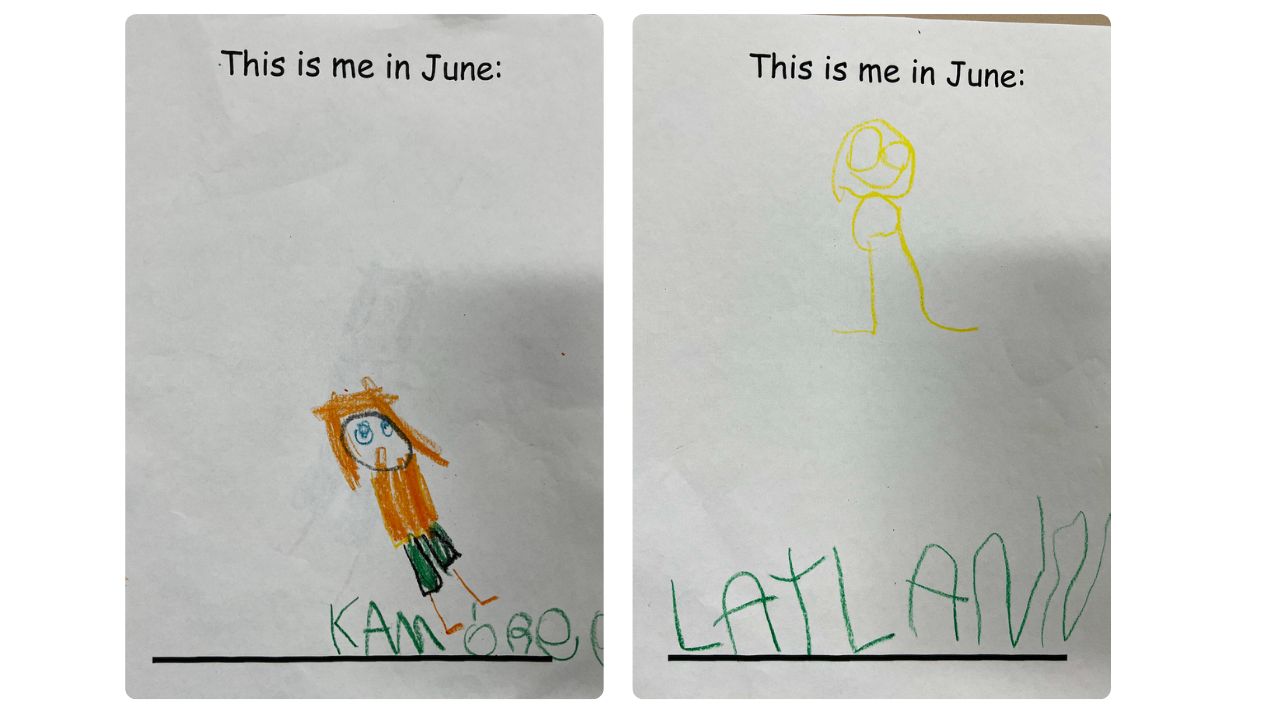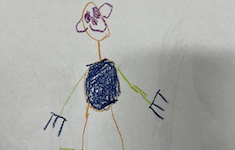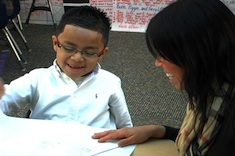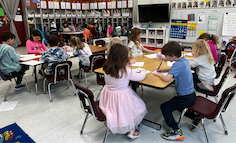“Becca, you have the data you need for your first writing small groups before the school year even starts.”
I scrunched my brow while I processed what my friend Katie had said as I sat in the parking lot of my school the week before the year started and chatted with her.
I was telling her how I had my incoming students do a self-portrait when they came to meet me in June, and how excited I am to hang the self-portraits for the kids to see when they walk into our room for the first time this school year. Back in June, when I was planning to meet my new students, I definitely didn’t envision using these self-portraits to inform some of my early instruction… but how incredible is it that I can?
These self-portraits act as a grounding tool for us as we start this year together. They will hang on our walls, saying, “We are already writers; we are important here; we are valued here; we have a space here.” When a child begins to doubt themselves, we can simply look up to the wall and remember, We have already done this writing thing, and it was so loved and celebrated, it’s hung on the wall for all to see. Surely I can do that again.
By assessing the self-portraits, I see who has a grasp on representational drawing and who doesn’t yet. I see who is confident in name writing, even writing some words, and who is still earlier in the writing development process. Ideas of what my early interactive and shared writing sessions could focus on flowed into my brain, and with those ideas came my excitement. Using a rubric allows me to begin grouping students and know how to strengthen them as writers.
| Child | |||||
| Prewriter | Early PreK | End of PreK | Early K | Mid K | |
| Name writing | No name | Attempt at name | Some letters from first name | First name written accurately | First and last name written accurately |
| Human form | Scribbles/swirls | Blob, some shapes | Potato person, circular shape with arms and legs | Body with separate head and other extremities, some details beyond that | Body with all extremities, eyes, nose, mouth, fingers, hair, maybe other details |
| Extras | Clothes, styled hair | Patterns on clothes, accurate color usage |
|||
| Important to Note | |||||
A rubric to assess self-portraits from early writers.
Assessment in Action
When we notice patterns among our students, we are able to group them according to their needs. Here are the patterns emerging in my classroom and the way the rubric is helping me identify what students need next to grow as writers.
Early K Writers
 Zoey, Azalea, Harper, and Charlie have clear understanding of self, have included several body parts and details, and have written their names accurately. Zoey even added a word to her drawing. I will begin a small group with them talking about story structure and beginning/middle/end. I will walk them through the idea of a small moment, and I suspect they will be off and writing. I think they will naturally and quickly begin adding labels to their pictures and eventually discover sentences.
Zoey, Azalea, Harper, and Charlie have clear understanding of self, have included several body parts and details, and have written their names accurately. Zoey even added a word to her drawing. I will begin a small group with them talking about story structure and beginning/middle/end. I will walk them through the idea of a small moment, and I suspect they will be off and writing. I think they will naturally and quickly begin adding labels to their pictures and eventually discover sentences.
Azalea |
|||||
| Prewriter | Early PreK | End of PreK | Early K | Mid K | |
| Name writing | No name | Attempt at name | Some letters from first name | First name written accurately | First and last name written accurately |
| Human form | Scribbles/swirls | Blob, some shapes | Potato person, circular shape with arms and legs | Body with separate head and other extremities, some details beyond that | Body with all extremities, eyes, nose, mouth, fingers, hair, maybe other details |
| Extras | None Yet | Clothes, styled hair | Patterns on clothes, accurate color usage |
||
| Important to Note | |||||
Completed rubric for Azalea.
Another Group of Early K Writers

Although the rubric revealed the same assessment as the previous group, Willow and Tucker have different needs. Notice how their self-portraits are not as developed as the previous group’s. They are ready to add more details to their writing. I will work with them on closing their eyes and picturing what else is part of their story. After a few pictures with more detail, we will begin to explore labeling and naming things in the story so readers can read their writing with even more ease.
Willow |
|||||
| Prewriter | Early PreK | End of PreK | Early K | Mid K | |
| Name writing | No name | Attempt at name | Some letters from first name | First name written accurately | First and last name written accurately |
| Human form | Scribbles/swirls | Blob, some shapes | Potato person, circular shape with arms and legs | Body with separate head and other extremities, some details beyond that | Body with all extremities, eyes, nose, mouth, fingers, hair, maybe other details |
| Extras | Nothing yet | Clothes, styled hair | Patterns on clothes, accurate color usage |
||
| Important to Note | |||||
Completed rubric for Willow.
Early PreK Writers
Onry and Jaxxon are working on hand strength and fine-motor skills. I will take a step back with them and have them do their writing on bigger paper on the easel or taped to the wall. I will use broken crayons and have them write the letters as big as they can to cross their midline as they write. Another day I will use TheraPutty to have Onry and Jaxxon build their name and roll it back into a ball, all the while strengthening their hand muscles. I will also be sure to add play dough, pipe cleaners, and beads to morning choices in the early weeks and guide the boys to that choice.
Onry |
|||||
| Prewriter | Early PreK | End of PreK | Early K | Mid K | |
| Name writing | No name | Attempt at name | Some letters from first name | First name written accurately | First and last name written accurately |
| Human form | Scribbles/swirls | Blob, some shapes | Potato person, circular shape with arms and legs | Body with separate head and other extremities, some details beyond that | Body with all extremities, eyes, nose, mouth, fingers, hair, maybe other details |
| Extras | None yet | Clothes, styled hair | Patterns on clothes, accurate color usage |
||
| Important to Note | Multilanguage learner | ||||
Completed rubric for Onry.
Try It!
Take a look at Kambree and Laylynn’s self-portraits. Begin with the rubric, and then linger by considering strengths and what you might start with as their growth areas.
Taking this time with the self-portraits allows children to take what they are most comfortable with, themselves, and expand it to help them develop as writers. At the start of the year, children can be self-conscious and unsure of their abilities, especially if this is their first school experience. By basing instruction on the data from their self-portraits, I am able to start with a solid understanding of each child’s potential. I say this because a self-portrait is a lower-pressure demand than something like a three-page story or an unfamiliar response to reading. Children usually have a strong self-image and can represent it in a way that feels best to them. This representation can tell you many things such as fine-motor control, drawing development, name writing, letter formation, labeling, letter-sound correspondence, spatial awareness, directionality, ability to follow directions to meet expectations, and much more.
Overall, I could see that this class of incoming kindergartners needed some work with fine-motor strength and spatial awareness. In the first few days, we have done a lot of work with puzzles, play dough, blocks, and small bits of chalk and crayon in projects. We have created two class books so far and will continue writing them together to promote a sense of community while building our identity as a community of writers.
I can’t wait to journey with these young learners as they learn and grow in their identity as literacy learners.







